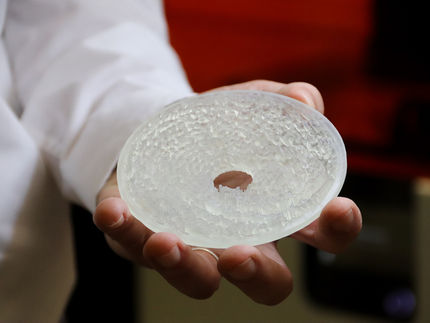New drug approach that could lead to cures for wide range of diseases
A team led by a longtime Oregon Health & Science University researcher has demonstrated in mice what could be a revolutionary new technique to cure a wide range of human diseases — from cystic fibrosis to cataracts to Alzheimer's disease — that are caused by "misfolded" protein molecules.
Misfolded protein molecules, caused by gene mutation, are capable of maintaining their function but are misrouted within the cell and can’t work normally, thus causing disease. The OHSU team discovered a way to use small molecules that enter cells, fix the misfolded proteins and allow the proteins to move to the correct place and function normally again.
The researchers were led by P. Michael Conn, Ph.D., who was a senior scientist in reproductive sciences and neuroscience at OHSU's Oregon National Primate Research Center and professor of physiology and pharmacology, cell biology and development and obstetrics and gynecology at OHSU for the past 19 years. This month, Conn joined Texas Tech University Health Sciences Center as senior vice president for research and associate provost.
The team’s work will be published this week in the early online edition of the Proceedings of the National Academy of Sciences.
Conn and his team perfected the process in mice, curing them of a form of disease that causes males to be unable to father offspring. The identical disease occurs in humans and Conn believes the same concept can work to cure human disease as well.
"The opportunity here is going to be enormous," said Conn, "because so many human diseases are caused by misfolded proteins. The ability of these drugs – called ‘pharmacoperones’ – to rescue misfolded proteins and return them to normalcy could someday be an underlying cure to a number of diseases. Drugs that act by regulating the trafficking of molecules within cells are a whole new way of thinking about treating disease.”
Proteins must fold into three-dimensional shapes in precise ways to do their work within human cells. Before recent discoveries about misfolded proteins, scientists believed that proteins that were inactive were intrinsically non-functional. But work by Conn and others revealed that, when the proteins are misfolded, the cell's "quality control system" misroutes them within the cell and they cease to function only because of that misrouting. Pharmacoperones can fix misfolded proteins and thus make them functional again.
Scientists had in recent years observed this process in cells under a microscope. The work of Conn's team is the first time the process has worked in a living laboratory animal.
“These findings show how valuable laboratory animals are in identifying new treatments for human disease,” said Conn. “We expect that these studies will change the way drug companies look for drugs, since current screening procedures would have missed many useful pharmacoperone drugs.”
A wide range of diseases are caused by an accumulation of misfolded proteins. Among the diseases are neurodegenerative diseases like Alzheimer's disease, Parkinson's disease and Huntington's disease. Other diseases include certain types of diabetes, inherited cataracts and cystic fibrosis.
Conn said the next steps will be clinical trials to see whether the same technique can work in humans.
Most read news
Topics
Organizations
Other news from the department science

Get the life science industry in your inbox
By submitting this form you agree that LUMITOS AG will send you the newsletter(s) selected above by email. Your data will not be passed on to third parties. Your data will be stored and processed in accordance with our data protection regulations. LUMITOS may contact you by email for the purpose of advertising or market and opinion surveys. You can revoke your consent at any time without giving reasons to LUMITOS AG, Ernst-Augustin-Str. 2, 12489 Berlin, Germany or by e-mail at revoke@lumitos.com with effect for the future. In addition, each email contains a link to unsubscribe from the corresponding newsletter.






















































